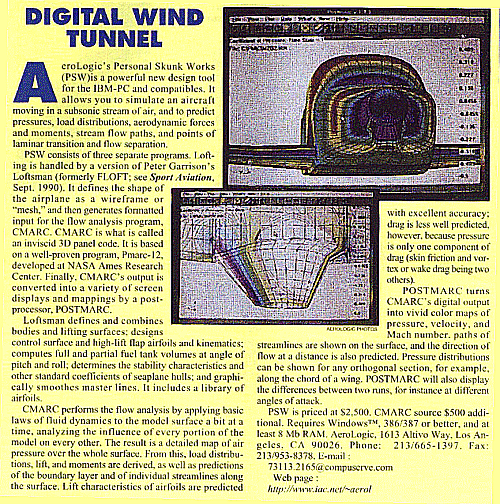News
Personal Simulation Works
Press Release
During AeroLogic's first full year of operation, this press release appeared in the December 1995 issue of Sport Aviation, the magazine of the Experimental Aircraft Association. It's somewhat confusing now, because its title has since become the name of one component of the PSW package, and it uses the original name of the software, Personal Skunk Works, which we had to abandon under dire pressure from Lockheed Corporation's killjoy lawyers.

Windows Cmarc
In mid-2003 we began distributing Cmarc as a Windows rather than a DOS executable. We had stuck with the DOS implementation for a long time because it permitted convenient batch processing; but Dave came up with a nice solution to the problem of setting up batch processes in Windows and also of delaying their execution, if necessary, to period of low demand on CPU time. The DOS version is still available on request, as is the UNIX-compatible source code for the command-line version of the program. The version numbers for Windows Cmarc begin with 5.0.
A New Loftsman/P Compilation
Ever since Loftsman/P was ported to Windows, it has been compiled with the Watcom C compiler. Watcom is defunct, however, and our compiler eventually gave up the ghost as well, for reasons that have remained mysterious. We finally quit swimming against the current and started compiling with Visual C++. The VC++ compiler caught quite a few coding errors that Watcom had been willing to ignore; the number of mysterious crashes will probably diminish with the new compilation, at least after a little time has passed. The last Watcom-compiled version was 4.6.2; the first Visual C++ compilation is Version 5.0 and became available late in 2003.
A version history for Loftsman/P is available for download. It is very detailed and makes for dull reading, but it might be useful if you are curious about how out-of-date the version you have is and what new features or bug fixes later versions might provide.
Prettier streamlines
Streamlines in lighter shades of yellow and green are hard to see against a white background, and hard to decipher when a model is transparent and streamlines on both sides are visible. Postmarc now provides the option of an alternative dark surface color to make streamlines stand out more clearly, and also offers hidden-line elimination, so that streamlines on the far side of the body are no longer visible.
Get OUT, finally
The DWT documentation now includes a much more detailed explanation of the OUT file. Cmarc and DWT also produce a new file, having an SCN extension, that presents section data for lifting surfaces in a more conveniently accessible form than the OUT file does.
Nonlinear Cmarc
After explaining to hundreds of clients and potential customers that an inviscid code is inherently incapable of computing pressure drag, early in 2005 we implemented an enhancement to Cmarc that does it. It is now possible to predict total drag with Cmarc and DWT, since frictional and induced drag were already calculated. Two limitations remain. First, the boundary layer must be attached over most of the model; while Cmarc assumes an empirically reasonable pressure coefficient under separated boundary layers, and in fact allows the user to set the value if he wishes, large regions of separated flow reduce the reliability of drag predictions. Second, the model surface is assumed to be smooth; there are currently no provisions for forcing laminar transition, although we may add them later. Drag predictions therefore tend to be optimistic compared to the actual drag of practical-construction airplanes. They coincide well, however, with NACA wind tunnel results on baseline 3D wings and streamlined bodies of revolution.
Boundary layer tripping
We have added to CMARC and DWT the ability to trip the laminary boundary layer along lines specified by the user, and have enabled POSTMARC both to implement a temporarily-defined trip in its boundary-layer analysis and to generate the properly formatted cards for making the trip part of the input file. Boundary layer tripping makes possible more accurate estimates of drag and lift for models with known gaps or seams or under conditions of service roughness.
Postmarc 2
A completely re-worked Postmarc is now (5/08) being delivered. A demo version, together with its manual and the sample files that it can process, is available for download. This program, which is based on the OpenGL graphics platform, has vastly improved graphics and a number of new capabilities, including interactive creation of off-body streamlines -- something like a smoke wand in a wind tunnel.
New copy protection scheme
As of July, 2016, we abandoned the hardware ("dongle") copy protection system in favor of a less cumbersome and costly software system. Existing keys continue to be supported, but henceforth customers will obtain a software key linking their codes to the computer on which they are installed. When users change computers, a new key will be provided.
